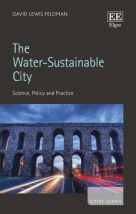The Water-Sustainable City: Science, Policy and Practice

There has been a contentious relationship throughout history between water and cities. Cities need water for their existence; yet their very existence threatens water resources and supply, and degrades water quality. The Water-Sustainable City explores this dynamic, and against a backdrop of global climate change and rapid urbanization, promotes “creative, low-energy, multi-disciplinary, and multi-benefit approaches to sustaining water resources”. Concomitantly, it also intends to address “the economic, legal, institutional, environmental, and political challenges generated by efforts to establish water-sensitive cities” (pages vii–viii and ix).
Principally the book considers how global water availability and quality are affected by our rapidly urbanizing planet, and what tools are available to analyse impacts of urban water consumption and choose approaches and policies to address threats to freshwater management (pages viii and 3). To do so, it draws upon a research project that links universities in two water-stressed regions of the US and Australia to develop and deploy urban water-sensitive initiatives (page ix).
The Water-Sustainable City comprises three sections and ten chapters. Part 1 is called “Our uncertain water future, our precarious water past”. Chapter 1 sets forth some principles and practices that might characterize a future water-sustainable city. In particular, it discusses three low-energy approaches for freshwater management: substitution, regeneration and conservation. Following on, Chapter 2 draws out lessons from a historical review of urban water management in cities and highlights the key role of infrastructure, laws and rules, and institutions. Considering the roles for civil engineering, law and institutions in urban water management, Chapter 3 turns to contemporary urban examples to examine the water anatomy of cities and how cities pursue water resilience. To end Part 1, Chapter 4 reviews, analyses and generalizes lessons from the experience of water management in two cities: Greater Melbourne and Los Angeles.
Part 2, entitled “Traditional and contemporary approaches to water management and policy innovation”, highlights the unique “vulnerability fingerprints” that cities around the world have in relation to water. Its chapters discuss two interrelated issues. Chapter 5 looks at the relationship between energy and water in cities by focusing on three general strategies to improve water productivity – initially identified in Chapter 1 (page 65). And Chapter 6 examines how cities value water, specifically through non-economic and economic valuation of water use.
Part 3, “The path forward: technology, infrastructure, institutions, practices”, considers across its four chapters ways to better manage water in cities around the world (page 95). In Chapter 7, Feldman looks at opportunities to address urban stream syndrome whilst also meeting urban water needs. Following on, Chapter 8 presents low-impact development innovations (demand-side approaches) for indoor and outdoor use. Chapter 9 considers new forms of management and governance of urban water sustainability. And to close, Chapter 10 revisits some of the challenges that stem from either too much or too little water in cities, which climate change will make more urgent.
Book note prepared by Hannah Keren Lee
Search the Book notes database
Our Book notes database contains details and summaries of all the publications included in Book notes since 1993 - with details on how to obtain/download.
Use the search form above, or visit the Book notes landing page for more options and latest content.
For a searchable database for papers in Environment and Urbanization, go to http://eau.sagepub.com/

